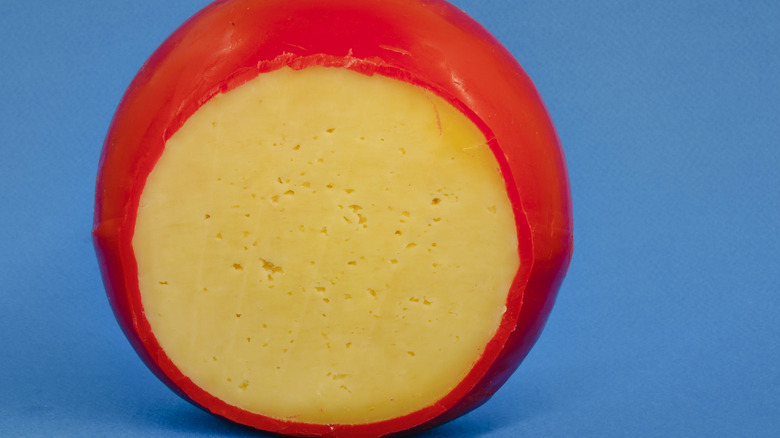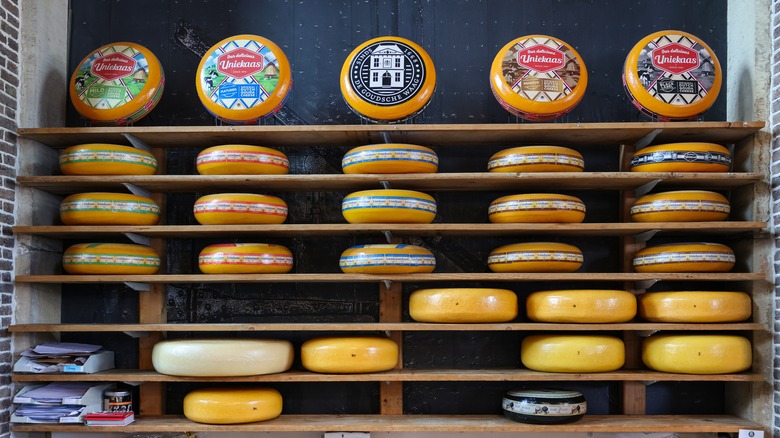Why Some Cheeses Need A Wax Rind And Others Don't
Some types of cheese rinds occur naturally, developing as a protective coating during the aging process. Other types of rind, however, are introduced by the cheesemaker. Washed rind cheeses, for example, typically grow their aromatic coatings via a brine that promotes the growth of an edible mold. So-called bloomy rind cheeses also produce a rind from edible mold — although in their case, it comes from sprayed-on spores.
These types of cheese rinds are edible. Wax rind cheeses and those bound in cloth, by contrast, are not — though the wax is safe to eat if it's accidentally consumed. Why are certain cheeses coated in wax? Just as some cheesemakers want mold to grow on their cheeses, others do not. It all depends upon the preferred flavor profile. Wax is almost exclusively used on semi-hard cheeses (Dutch Gouda being a classic example), and its use prevents oxygen exposure and any kind of mold growth. It also helps to seal in the cheese's moisture and keeps it from drying out. However, there is some debate about their safety concerning anaerobic bacteria, such as botulism (per Utah State University).
It's an anaerobic rather than aerobic method of cheese aging, and something of a recent innovation, at least by cheese standards, as wax wasn't used as a rind option until the latter part of the 19th century.
The invention of wax rind cheeses
There's a reason Dutch cow's milk cheeses like Gouda and Edam are famous for their wax rinds. This rind style was invented in the Netherlands during the 19th century for use in these famous cheeses. However, it bears noting that each style had been made for centuries before this innovation occurred.
Gouda, for instance, has a history that dates back to 1184, and it is reputed to be one of the world's oldest cheeses still made using the same original recipe. Edam, too, has been made since the Middle Ages. These cheeses were originally sold at local markets but gained greater exposure with the rise of the Dutch East India Company during the 17th century and the subsequent sale of Dutch products in markets around the globe. This was an important factor in their evolution. Dye was originally used to color and harden the Dutches cheeses but was eventually replaced by paraffin-based wax rinds, which in addition to their anaerobic qualities, made Gouda and Edam instantly recognizable to consumers in foreign markets.
The wax also helped to preserve the cheeses for long sea voyages, and unlike dyes, it kept the cheeses from becoming chipped or otherwise damaged during travel.
Which cheeses besides Gouda and Edam feature wax rinds?
As the origin of wax rind cheeses suggests, there were numerous factors at play besides flavor profile. The colorful red, yellow, and orange waxes were as much a marketing tool as they were a preservative. Flavor was also a deciding factor, however, due to the pioneering Dutch use of spices in their exported cheese products.
Nowadays, the Netherlands is still a leader in the use of wax on cheeses, notably with Gouda and Edam. But this rind style is also used on cheeses in other nations as well, from some types of manchego cheeses produced in Spain to cheddar and Cheshire cheeses in the U.K. The reasons for its use remain the same in almost every instance. Wax rinds prevent unwanted mold growth, keep the cheeses moist, and allow them to remain fresh even when shipped and sold in far-flung markets.
These wax rinds are not meant to be consumed, of course, and are quite easy to remove. They can also be recycled afterward. Candle making, for example, is a popular way to repurpose them.



